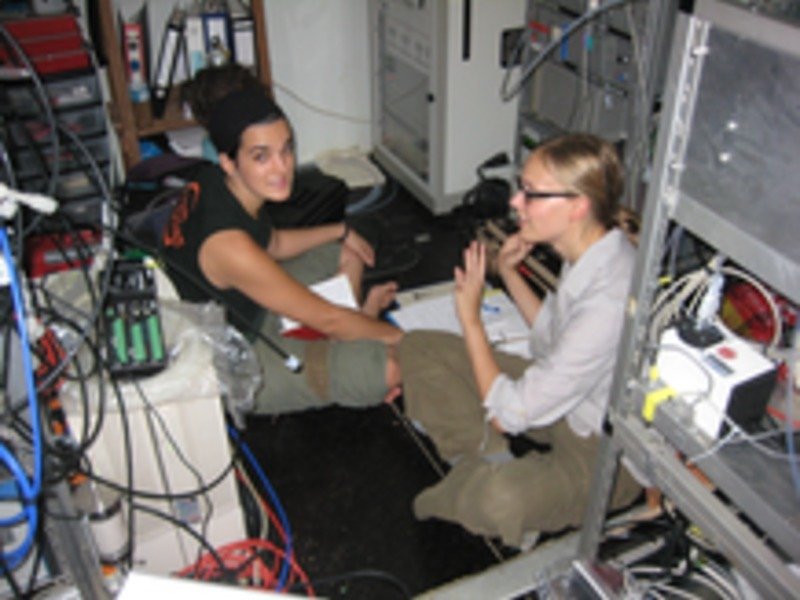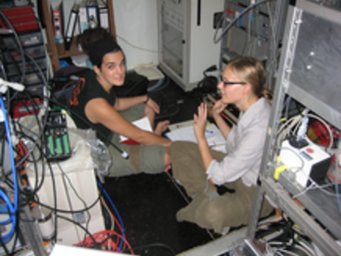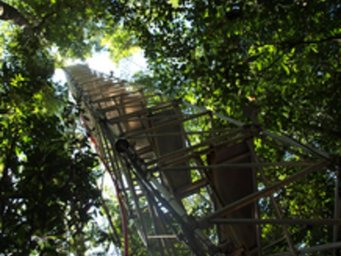Study on rainforest atmosphere raises new questions
Large amounts of yet unidentified trace gases are involved in self-cleaning process of the air – isoprene alone cannot explain the loss rate of hydroxyl radicals in tropical regions.
Our atmosphere has an efficient means of self-purification which takes the form of a cleaning agent known as the hydroxyl radical (OH). These radicals oxidize hydrocarbons such as the greenhouse gas methane and toxic exhaust gases from traffic and industrial activity, so that such pollution can be washed away with the rain. This purification process takes place mainly above the tropics. Up until recently, it was presumed that the volatile organic compound isoprene made up the largest proportion of the reactants for OH. However, a current study by the Max Planck Institute (MPI) for Chemistry, published in the magazine "Nature Communications" at the end of January, is now showing that isoprene is only responsible for roughly 20 percent of the OH reaction rate in the tropical Amazon rain forest - in the dry season. The compound or compounds which account for the remaining, critical 80 percent have yet to be discovered.

Jonathan Williams, in collaboration with the research group of Jürgen Kesselmeier - a fellow team leader at the MPI for Chemistry - and the Instituto Nacional de Pesquisas da Amazonia (INPA) in Brazil, studied the the lower 80 meters of the Amazonian atmosphere for a whole year. Throughout the course of this observation, the researchers stumbled across something unexpected. A comparison of the overall reactivity rate of hydroxyl radicals with levels of individually measured trace gases, such as isoprene, revealed significant gaps. In the rainy season, 5 to 15 percent of the OH reactivity could not be explained and this figure was as much as 80 percent during the dry season.
"Previously, it had been assumed that isoprene was the main OH radical reactant in the rainforest area. Our comparative reactivity measurements reveal the presence of undiscovered OH reactants, ones that our measurements of single compounds did not record," concludes Jonathan Williams. "What we have discovered can easily be compared to dark matter in astronomy. We know it exists, but we can't explain what it is or where it comes from. Similarly, we have now found that significant quantities of unidentified trace gases are present in tropical air but we do not know what they are or how they are generated. However, it is clear to us that they must exist," he adds.
Jürgen Kesselmeier was also astonished by the new findings: "There are always surprises in store for us working in natural conditions in an ecosystem such as the Amazonian rain forest. The sheer number of already known volatile compounds emitted into the atmosphere by trees is breathtaking in itself. Now, we have a measure of the extent of the task ahead."
Last year, work on the construction of the ATTO climate measurement tower in the Amazon rain forest was finally concluded with support from the Max Planck Institute (MPI) for Biogeochemistry in Jena. The researchers hope to be able to answer the questions raised by their current study by taking further measurements at the lofty heights of the ATTO. "At 300 meters, you immerse in exactly that zone in which atmosphere's cleaning process takes place." Here we will be right in the midst of the breath of the rain forest as it meets the atmosphere’s cleaning mechanisms, with a chance to unmask these unknown chemicals," says Jonathan Williams, looking into the future.
To put this into context:
There are two reasons which have, so far, led to the conclusion that isoprene is the main OH radical reactant: First, the volatile organic compound possesses a very high reactivity. Second, isoprene accounts for a large part of known emissions throughout the world - approximately half of all biogenic emissions are attributed to isoprene. Global isoprene emissions are roughly three times as high as all anthropogenic emissions put together.

Auch Jürgen Kesselmeier überraschten die neuen Daten: „Arbeiten unter natürlichen Bedingungen in einem Ökosystem wie dem Amazonas Regenwald sind immer für Überraschungen gut. Allein die Anzahl der schon bekannten flüchtigen Verbindungen, die die Bäume an die Atmosphäre abgeben, ist atemberaubend hoch. Jetzt müssen wir wohl auch noch einige bisher unbekannte Spurengase suchen.“
Im vergangenen Jahr konnte der 325 Meter hohe ATTO Klimamessturm mit Unterstützung des Max-Planck-Instituts für Biogeochemie in Jena im Amazonas Regenwald fertig gestellt werden. Die Forscher hoffen, die durch ihre jetzige Studie aufgeworfenen Fragen anhand weiterer Messungen in den luftigen Höhen von ATTO klären zu können. „Auf 300 Metern taucht man genau in die Zone ein, in der der Reinigungsprozess der Atmosphäre abläuft. Dort sind wir mittendrin im Atem des Regenwaldes und können die unbekannten Chemikalien entlarven“, wirft Jonathan Williams einen Blick auf die Zukunft.
Hintergrundinformation:
Vor allem zwei Gründe sprachen bisher dafür, dass Isopren der Hauptreaktionspartner der OH-Radikale ist: Einerseits besitzt die flüchtige organische Verbindung eine hohe Reaktionsfähigkeit (auch als Reaktivität bezeichnet). Andererseits macht Isopren weltweit einen Großteil der bekannten Emissionen aus - rund die Hälfte aller biogenen Emissionen weltweit wird Isopren zugeschrieben. Globale Isopren Emissionen sind etwa dreimal so hoch wie alle anthropogenen Emissionen zusammen genommen.

